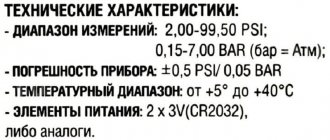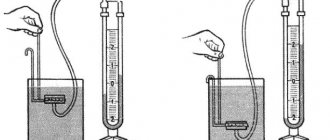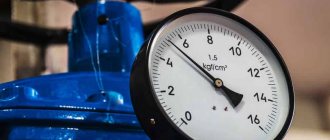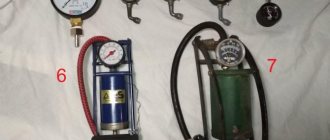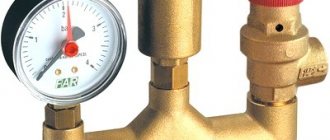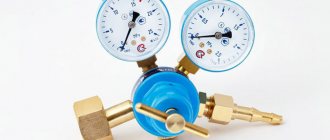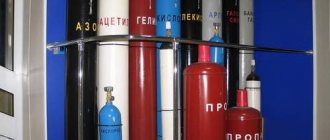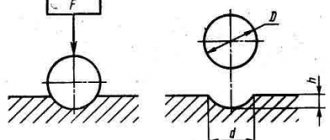Exact sciences
The unit of measurement of pressure in physics and chemistry is the letter “P” (translated into Latin as “pressūra”). If there is equilibrium inside and outside the cylinder walls, the indicator is designated “P”. The international system uses Pascals. Using the formula for fluid pressure and force, we can come to the conclusion that 1 Pa = 1 N/ 1 sq. m. Since the unit is small, it is difficult to use in calculations.
From the table of standard converters in physics, the following notations are more often used:
- Bars. 1 Bar=105 Pa.
- Torrs or mmHg (1 torr equals 133 Pa).
- mm water pillar
To determine pressure, force and area are used: P = mg / S. There is a dependence of the value on volume and mass. The indicator is characterized by the following property: the smaller the area, the greater the force exerted on the body. If the pressure does not change, but S increases, then the desired indicator decreases.
General information about pressure
The maintained gas pressure depends on the purpose of the pipeline
By definition, pressure is a physical quantity equal to the force that acts per unit area at 90° to the surface. Since blue fuel is transmitted through pipelines, the cross-sectional area of the pipe is the conventional surface, and the pressure determines the speed of movement of the substance.
The pressure in different sections of the gas pipeline from the field to the nozzle in the gas boiler is maintained at different levels.
Types of pressure
The pressure in the pipes is strictly standardized. If the value in the main pipe is too small, it will simply not be possible to move the gas to another station. If the pressure in the home network is too high, at the final point - the burner, the gas mixture will not be able to be mixed with oxygen in the required proportion to support combustion and not provoke an explosion.
Gas pipelines are classified according to the pressure. And since it is constantly maintained, the gas is “associated” with this value.
There are main and distribution gas pipelines.
Trunk
Distribution
Trunk - through such a pipeline the gas mixture is transmitted over long distances. Gas compressor stations are installed here at a certain frequency to maintain the required level. The final destination for the main line is the local distribution station. Based on the pressure level, there are 2 types:
- 1st class trunk networks – with operating pressure from 2.5 to 11.8 MPa inclusive;
- Class 2 – maintained according to the standard 1.2–2.5 MPa.
Distribution - gas is delivered through pipelines from stations to the end consumer - in-house networks. There are:
- Category 1 – household gas is transmitted under pressure from 0.6 to 1.2 MPa;
- category 1a – more than 1.2 MPa;
- Category 2 – 0.3–0.6 MPa.
Residential buildings are traditionally equipped with the lowest pressure networks. However, with the advent of gas boilers, the situation has changed somewhat. To satisfy the demand for gas, a gas pipeline with average performance is connected to residential multi-storey buildings.
Units
Pressure is measured in a variety of ways. But when it comes to a gas line, the following options are most often used:
- 1 mm. Hg st - this unit is very clear, especially when a liquid pressure gauge is used for measurement.
- 1 atm is a more traditional unit of measurement. The first quantity that could be compared with something was atmospheric pressure. The value calculated from absolute zero is called absolute. Hence, excess pressure is equal to the difference between the absolute and atmospheric values. When the vacuum changes, it is determined how much the level in a certain limited volume - a pipeline - is less than atmospheric. This value is called vacuum pressure. When repairing or inspecting intra-house networks, vacuum pressure is measured in the smoke removal system, and excess pressure is measured in the gas pipeline.
- 1 bar is a unit more common in Europe. 1 bar is equal to 100000 Pa.
- 1 Pa is the unit of measurement adopted in the SI system. It is inconvenient because it is too small - only 1 newton per 1 m². When inspecting gas pipelines, a large unit is used - 1 MPa, equal to 1,000,000 Pa (pascals).
Determination of pressure value
Pressure
is a quantity characterizing the action of a force per unit surface.
When determining the pressure value, it is customary to distinguish between absolute, atmospheric, excess and vacuum pressure.
Absolute pressure (p a )
- this is the pressure inside any system under which a gas, vapor or liquid is located, measured from absolute zero.
Atmospheric pressure (p in )
created by the mass of the air column of the earth's atmosphere. It has a variable value, depending on the altitude of the area above sea level, geographic latitude and meteorological conditions.
Overpressure
determined by the difference between absolute pressure (pa) and atmospheric pressure (pv):
Vacuum (underpressure)
is a state of gas in which its pressure is less than atmospheric. Quantitatively, vacuum pressure is determined by the difference between atmospheric pressure and absolute pressure inside the vacuum system:
Read also: Plastic injection molding machine
When measuring pressure in moving media, the concept of pressure refers to static and dynamic pressure.
Static pressure ( pst )
– this is pressure depending on the potential energy reserve of a gas or liquid medium; determined by static pressure. It can be excess or vacuum, in a particular case it can be equal to atmospheric.
Dynamic pressure ( pd )
– this is the pressure caused by the speed of the gas or liquid flow.
Total pressure (p p )
moving medium consists of static (рst) and dynamic (рд) pressures:
Pressure measurement methods
The widespread use of pressure, its differential and vacuum in technological processes necessitates the use of a variety of methods and means of measuring and monitoring pressure.
Pressure measurement methods are based on comparing the forces of the measured pressure with the forces:
- pressure of a column of liquid (mercury, water) of the corresponding height;
- developed during deformation of elastic elements (springs, membranes, pressure boxes, bellows and pressure tubes);
- elastic forces that arise during deformation of some materials and cause electrical effects.
Classification of pressure measuring instruments
Classification by principle of action
In accordance with these methods, pressure measuring devices can be divided, according to the principle of operation, into:
Deformation measuring instruments are most widely used in industry. The rest, for the most part, have found application in laboratory conditions as exemplary or research ones.
Classification depending on the measured value
Depending on the measured value, pressure measuring instruments are divided into:
- pressure gauges – for measuring excess pressure (pressure above atmospheric);
- micromanometers (pressure meters) – for measuring small excess pressures (up to 40 kPa);
- barometers - for measuring atmospheric pressure;
- microvacuum gauges (draft meters) – for measuring small vacuums (up to -40 kPa);
- vacuum gauges – for measuring vacuum pressure;
- pressure and vacuum gauges – for measuring excess and vacuum pressure;
- pressure gauges – for measuring excess (up to 40 kPa) and vacuum pressure (up to -40 kPa);
- absolute pressure gauges – for measuring pressure measured from absolute zero;
Study of the purpose, design, principle of operation and calibration of pressure measuring devices (absolute, manometric, vacuum).
Pressure measuring instruments
Devices for measuring pressure are classified according to various criteria. Based on the nature of the measured pressure, devices are divided into the following classes:
- barometers – instruments for measuring atmospheric pressure:
- pressure gauges – devices for measuring excess pressure;
- vacuum gauges – instruments for measuring vacuum;
- pressure and vacuum gauges – devices for measuring both excess pressure and vacuum;
- absolute pressure gauges – devices for measuring absolute (total) pressure;
- differential pressure gauges – devices for measuring pressure differences.
According to the principle of operation, the devices are distinguished:
The simplest device for measuring excess pressure is a piezometer (Fig. 1, a). It is a vertically installed transparent glass or PVC tube with an open top end
Measurements using a piezometer are carried out in units of length, so sometimes pressures are expressed in units of the height of a column of a certain liquid. Piezometer height 1.5. 2m allows you to measure pressure up to 0.15. 0.20 atm.
The main advantage of a piezometer is its simplicity of design and measurement accuracy. The main disadvantage of a piezometer is the small range of measured pressures. At high pressures the piezometer becomes too bulky. The disadvantages of a piezometer also include fragility.
Excess pressure in liquids or gases is measured by pressure gauges. This is a very extensive set of measuring instruments of various designs and designs.
Figure 1,b shows the operation diagram of a piston pressure gauge. When the pressure in the vessel increases, the liquid or gas, according to Pascal's law, transfers this pressure to the lower surface of the piston, thereby causing it to rise or fall. The piston is connected through a system of levers with an indicator arrow.
Fig.1 Instruments for measuring excess pressure
a) piezometer, b) piston pressure gauge, c) liquid pressure gauge, d) membrane pressure gauge, e) bellows pressure gauge
Another type of pressure gauge is an open (liquid) pressure gauge (Fig. 1, c). It consists of a U-shaped tube filled with mercury or other liquid. The work is based on the law of communicating vessels and on balancing the measured gas pressure with the pressure of a liquid column (mercury, water, etc.). Pressure is applied to one end of the tube. The liquid in the other tube rises until the measured pressure is exactly equal to the pressure caused by the difference in liquid levels in the two legs of the tube. Knowing this height difference, the pressure can be calculated.
The disadvantage of such a pressure gauge is that the pressure value depends on the acceleration of gravity at a given location. Such a pressure gauge is not always calibrated in pascals; it is often convenient to measure pressure in units of the height of a column of a given liquid - in millimeters of mercury, water column (1 mm water column - 9.8 Pa; 1 mm Hg = 133.3 Pa)
One of the simple instruments for measuring increased and high pressures is a tubular pressure gauge or Bourdon pressure gauge. Its main component is a brass pipe 1 of oval cross-section bent in an arc (Fig. 2).
Liquid or gas is supplied to fitting 3, connected to tube 1. The tube, straightening, sets in motion a system of gears and levers 2, which turn arrow 4; the greater the pressure, the greater the angle the needle will rotate. The angle of rotation of the arrow is proportional to the measured pressure. The scale printed on the dial is graduated in pressure units. Typically the pressure gauge is calibrated in MPa. Such pressure gauges are used to measure the pressure of air, steam, gases and liquids. Pressure gauges for measuring car tire pressure are often of the Bourdon type.
So it is a strain gauge.
Deformation gauges also include membrane and bellows pressure gauges (Fig. 1, d, e)
The main part of the diaphragm pressure gauge is a flexible round flat plate capable of deflection under pressure.
A bellows pressure gauge (bellows) is a thin-walled cylindrical shell with transverse corrugations, capable of significant movement under pressure. To increase rigidity, a spring is often placed inside the bellows. Bellows are made of bronze, carbon steel, aluminum alloys. Seamless and welded bellows with a diameter from 8-10 to 80-100 mm are mass-produced. Bellows are more sensitive than diaphragm pressure gauges and have a larger measuring range.
The main advantages of the devices are a wide range of measured pressures, simplicity of design and use, portability and versatility.
The main disadvantage of the devices is the variability of their readings, due to gradual changes in the elastic properties of the spring element, the occurrence of residual deformation, and wear of the transmission mechanism. Therefore, such devices must be checked periodically.
Pressure gauges allow you to determine pressure only with a certain accuracy; the accuracy class of pressure gauges is determined by the value k, which expresses the maximum permissible error of the value corresponding to the maximum reading of the instrument scale
Nominal range of classes, accuracy of pressure gauges: 0.005; 0.02; 0.05; 0.1; 0.2; 0.35; 1; 2; 2.5; 4.0; 6.0.
Pressure gauges and vacuum gauges, standard spring gauges, are used to control general-purpose pressure gauges and to carry out particularly precise measurements. To control standard pressure gauges, deadweight piston pressure gauges are used.
Pressure gauges of class 0.05 are intended for testing standard spring and other precision pressure gauges, pressure gauges of class 0.2 are for testing technical general-purpose pressure gauges.
Liquid pressure gauges and differential pressure gauges, principle of operation, scope of application
Liquid (pipe) pressure gauges operate on the principle of communicating vessels - by balancing the fixed pressure with the weight of the filler liquid: the liquid column shifts to a height that is proportional to the applied load. Measurements based on the hydrostatic method are attractive due to their combination of simplicity, reliability, cost-effectiveness and high accuracy. A pressure gauge with liquid inside is optimal for measuring pressure drops within 7 kPa (in special versions - up to 500 kPa).
Types and types of devices
For laboratory measurements or industrial applications, various versions of pressure gauges with a tube design are used. The following types of devices are most in demand:
- U-shaped. The basis of the design is communicating vessels in which pressure is determined by one or several liquid levels at once. One part of the tube is connected to the piping system to take the measurement. At the same time, the other end can be hermetically sealed or have free communication with the atmosphere.
- Cupped. A single-tube liquid pressure gauge is in many ways similar to the design of classic U-shaped instruments, but instead of a second tube, it uses a wide reservoir, the area of which is 500-700 times larger than the cross-sectional area of the main tube.
- Ring. In devices of this type, the liquid column is enclosed in an annular channel. When the pressure changes, the center of gravity moves, which in turn leads to the movement of the indicator arrow. Thus, the pressure measuring device records the angle of inclination of the axis of the annular channel. These pressure gauges attract high accuracy of results that do not depend on the density of the liquid and the gaseous medium on it. At the same time, the scope of application of such products is limited by their high cost and complexity of maintenance.
- Liquid piston. The measured pressure displaces the extraneous rod and balances its position with calibrated weights. By selecting the optimal parameters for the mass of the rod with weights, it is possible to ensure its ejection by an amount proportional to the measured pressure, and, therefore, convenient for control.
Application of Liquid Pressure Gauge
The simplicity and reliability of measurements based on the hydrostatic method explain the widespread use of liquid-filled devices. Such pressure gauges are indispensable when conducting laboratory research or solving various technical problems. In particular, the instruments are used for the following types of measurements:
- Slight overpressure.
- Pressure difference.
- Atmosphere pressure.
- Underpressure.
An important area of application of pipe pressure gauges with liquid filler is the verification of control and measuring instruments: draft gauges, pressure gauges, vacuum gauges, barometers, differential pressure gauges and some types of pressure gauges.
Liquid pressure gauge: principle of operation
The most common device design is a U-shaped tube. The operating principle of the pressure gauge is shown in the figure:
Schematic of a U-shaped liquid pressure gauge
One end of the tube has a connection with the atmosphere - it is exposed to atmospheric pressure Patm. The other end of the tube is connected to the target pipeline using supply devices - it is exposed to the pressure of the measured medium Rab. If the Rabs indicator is higher than Patm, then the liquid is displaced into a tube communicating with the atmosphere.
Calculation instructions
The height difference between liquid levels is calculated by the formula:
h = (Rabs – Ratm)/((rzh – ratm)g) where: Rabs – absolute measured pressure. Ratm – atmospheric pressure. rzh – density of the working fluid. ratm – density of the surrounding atmosphere. g – gravitational acceleration (9.8 m/s2) The height indicator of the working fluid H is made up of two components: 1.
h1 – decrease in column compared to the original value. 2. h2 – increase in the column in another part of the tube compared to the initial level. The ratm indicator is often not taken into account in calculations, since rl >> ratm. Thus, the dependence can be represented as: h = Rizb/(rzh g) where: Rizb is the excess pressure of the measured medium.
Based on the above formula, Rizb = hrж g.
If it is necessary to measure the pressure of discharged gases, measuring instruments are used in which one of the ends is hermetically sealed, and vacuum pressure is connected to the other using supply devices. The design is shown in the diagram:
Classification by type of pressure measured
Instruments used to obtain data on gas pressure parameters in gas tanks, transport lines, gas cylinders and other reservoirs are classified according to several criteria. They differ in their structure and principle of operation.
Devices used to measure pressure are divided into classes according to:
- type of pressure being measured;
- purpose;
- operating principle;
- accuracy class.
Based on the type of pressure being measured, instruments designed to determine accurate indicators are divided into pressure gauges, vacuum gauges, draft gauges, pressure gauges, barometers and others.
Depending on the degree of protection from the influence of the external environment, the following devices are produced:
- standard;
- protected from dust;
- waterproof;
- protected from aggressive environments;
- explosion-proof.
One product can combine several types of protection.
The diagram shows the division of measuring devices according to operating principle, type of pressure, application and display. Liquid and deadweight instruments are rarely used to obtain data on gas pressure
A pressure gauge is a small device that is used to measure pressure or pressure difference. The operating principle of this instrument depends on its internal structure. Within one class, they are further divided into groups depending on the accuracy class.
To measure absolute pressure, measured from absolute zero (vacuum), absolute pressure gauges are used. Excess pressure is determined using an excess pressure gauge. In general, all varieties of such devices are called in one word: “pressure gauge”.
Most types of pressure gauges are designed to measure excess pressure values. Their peculiarity is that they show pressure, representing the difference between absolute and atmospheric.
Vacuum gauges are devices that indicate the pressure value of a rarefied gas. Using pressure and vacuum gauges, excess pressure and rarefied gas pressure are measured. Information is displayed on a single scale.
Using pressure meters, excess pressure parameters are determined with values up to 40 kPa. Traction meters, on the contrary, make it possible to measure rarefaction down to – 40 kPa. Thrust pressure meters measure rarefaction and excess pressure in the range from – 20 to + 20 kPa.
Pressure gauges are used in a wide variety of industries. Working with gas involves a high risk, so it is important to monitor all system indicators. Pressure information gives users information about the current state of the object being measured
Differential pressure gauges can be used to determine the pressure difference at two arbitrary points to be studied. A micromanometer is a differential pressure gauge that allows you to measure pressure differences within 40 kPa.
Description of atmospheric pressure measuring instruments
06/19/2015
Air pressure varies widely. If it is more than 760 millimeters of mercury, then it is considered elevated
, if less, then
reduced
.
Observations of changes in atmospheric pressure make it possible to predict the weather. For example, when pressure increases in winter, the weather becomes frostier, and in summer it becomes hot.
Low atmospheric pressure contributes to cloudiness and precipitation.
Therefore, constantly knowing the value of atmospheric pressure and monitoring its changes is necessary not only for scientists and doctors, but for all of us.
Atmosphere pressure
Atmospheric pressure is measured in millimeters of mercury, as well as in Pascals and hectoPascals. Normal blood pressure is considered to be 760 mmHg. Art. (1013.25 hPa) .
Atmospheric pressure generally changes with changes in weather conditions. Often, pressure drops before inclement weather and rises before good weather. Keeping records of pressure changes allows you to determine the movement of cyclones and the direction of winds.
A change in characteristic pressure often does not affect the well-being of a person living for a long time in a certain area. In cases where non-periodic fluctuations in atmospheric pressure occur, even healthy people experience headaches, decreased performance and a feeling of heaviness in the body.
Changes in atmospheric pressure also affect many technological processes.
For example, when processing petroleum products, where pressure is one of the main controlled technical parameters; bakery production, where pressure readings greatly affect the moisture content of semi-finished dough products; in the aviation industry this is a very important parameter that affects the terms and conditions of operation.
Instruments for measuring atmospheric pressure
Today, there are several types of barometers that are used to measure air pressure:
- Mercury siphon barometer - represents a Y-shaped tube filled with mercury with an open and sealed end.
- Mercury cup barometer - consists of a vertical tube filled with mercury, the upper end of which is sealed, and the lower end is in a special cup with mercury.
- An aneroid barometer is an airless metal box with wavy walls.
- A barograph is a self-recording instrument that is used to monitor barometric pressure at certain periods of time.
- An electronic barometer is a digital device that operates on the principle of a conventional aneroid or on the principle of measuring air pressure on a sensitive crystal.
Mercury barometers are more accurate and reliable compared to aneroids; they are used to check the operation of other types of barometers. The height of pressure in them is determined by the height of the mercury column. Meteorological stations are equipped with cup barometers.
Measuring atmospheric pressure using a thermohygrometer
Atmospheric pressure is measured not only using various types of barometers, but also with such universal digital instruments as thermohygrometers.
Despite the fact that the main task of these devices is to determine relative humidity and temperature, they also do an excellent job of measuring air pressure, showing the most accurate values.
Therefore, such multifunctional devices are much more profitable to purchase than outdated barometers and psychrometers.
JSC "EXIS" brings to your attention a huge range of electronic pressure meters and other high-quality control and measuring instruments and always at affordable prices.
In particular, in our company you can purchase the following models of thermohygrometers:
- Thermohygrometer IVTM-7 M 2-D-V
. The device, in addition to measuring and recording temperature and relative humidity of air and other non-aggressive gases, measures atmospheric pressure in millimeters of mercury and hPa, can record data in non-volatile memory, recalculate measurement results into various units (percentage of relative humidity, g/m3), carry out simultaneous indication of measured values. IVTM-7 M 2-D-V has a high degree of dust and moisture protection (IP65), making it possible to use it in rooms with high humidity. - Thermohygrometer IVTM-7 K-1
. The device measures atmospheric pressure in kPa, can recalculate the values of various humidity units, carry out simultaneous indication of measured values, record data on microSD, it is possible to connect various types of primary transducers. - Thermohygrometer IVTM-7 R-03-I-D
. The device is equipped with a liquid crystal indicator designed for visual monitoring of relative humidity, temperature and pressure values. It has small dimensions and an ergonomic body. - Thermohygrometer IVTM-7 M 6-D (in an ergonomic housing).
The device measures atmospheric pressure in kPa, can record data on a non-volatile memory card, recalculate measurement results into various units, and simultaneously display the measured values. It has an ergonomic body and a large and convenient display. - Thermohygrometer IVTM-7 M 3-D-V
. The device, in addition to measuring and recording temperature and relative humidity of air and other non-aggressive gases, measures atmospheric pressure in millimeters of mercury and hPa, can record data in non-volatile memory, recalculate measurement results into various units (percentage of relative humidity, g/m3), carry out simultaneous indication of measured values. Model IVTM-7 M3-D-V is intended for creating a measuring network. The degree of moisture protection of the housing and sensor is IP65, which makes it possible to use it in rooms with high humidity. - Thermohygrometer IVTM-7 M 6-D.
The device measures atmospheric pressure in kPa, can record data on a non-volatile memory card (microSD), recalculate measurement results into various units, and simultaneously display the measured values.
All models of thermohygrometers have a communication interface with a PC via USB, RS-232 and can be mounted on a wall.
Reference devices for pressure measurement
This type of pressure gauge is designed to test, calibrate and adjust other instruments to ensure the highest possible measurement accuracy. Such devices are distinguished by a higher accuracy class in comparison with general technical ones. Working standards are divided into three categories.
Control pressure gauges, used to monitor the reliability of the readings of measuring instruments at the installation site, are also called high-precision pressure gauges. The operating measurement range is from 0-0.6 to 0-1600 bar for gaseous media.
Pressure gauges for conventional and composite gas cylinders must undergo a verification procedure at least once a year, unless other periods are specified in the documents for the device. Verification is carried out by accredited metrological organizations that have the status of legal entities. After verification, a certificate is issued and a stamp is placed.
The device must be removed from the cylinder and taken to the metrological service. There, verifiers and calibrators, using a set of standards and auxiliary instruments, will carry out verification for about 10 days
The transmission mechanisms in the reference pressure gauges are machined at a higher gearing frequency. They are characterized by minimal friction in the pointer mechanism, as well as high sensitivity of the internal elements.
Standard pressure gauges with an accuracy class of 0.4 have a scale of 250 units, with an accuracy class of 0.15 or 0.25 they have a scale of 400 units with a division value of 1 unit. Operation of the device is possible at different temperatures depending on the housing filler. The ideal operating temperature is 20 °C.
The following article will introduce you to the specifics of refilling gas cylinders. All owners of country property not connected to a centralized gas supply should read it.
What devices measure gas pressure
In many technological processes, pressure is one of the main parameters that determine their progress. These include: pressure in autoclaves and steam chambers, air pressure in process pipelines, etc.
What devices measure gas pressure - Metalist's Handbook
May 11, 2021
In hydraulic fracturing, the following instrumentation is used to monitor the operation of equipment and measure gas parameters:
- thermometers for measuring gas temperature;
- indicating and recording (self-recording) pressure gauges for measuring gas pressure;
- instruments for recording pressure drop on high-speed flow meters;
- Gas consumption metering devices (gas meters or flow meters).
All instrumentation must be subject to state or departmental periodic verification and be in constant readiness to perform measurements. Readiness is ensured by metrological supervision.
Metrological supervision consists of constantly monitoring the condition, operating conditions and correctness of instrument readings, periodically checking them, and removing from service devices that have become unusable and have not passed the test.
The instrumentation must be installed directly at the measuring point or on a special instrument panel. If the instrumentation is mounted on the instrument panel, then one device with switches is used to take readings at several points.
The instrumentation is connected to gas pipelines using steel pipes. Impulse tubes are connected by welding or threaded couplings. All instrumentation must have marks or seals of Rosstandart authorities.
Instrumentation with an electric drive, as well as telephone sets, must be explosion-proof, otherwise they are placed in a room isolated from the gas distribution center.
The most common types of instrumentation in hydraulic fracturing include the devices discussed later in this section.
Instruments for measuring gas pressure are divided into:
- for liquid devices in which the measured pressure is determined by the value of the balancing liquid column;
- spring devices in which the measured pressure is determined by the amount of deformation of elastic elements (tubular springs, bellows, membranes).
Liquid pressure gauges are used to measure excess pressures in the range of up to 0.1 MPa. For pressures up to 10 MPa, pressure gauges are filled with water or kerosene (at negative temperatures), and when measuring higher pressures - with mercury. Liquid pressure gauges also include differential pressure gauges (differential pressure gauges). They are used to measure pressure drop.
Differential pressure gauge DT-50 (figure below), Thick-walled glass tubes are firmly fixed in the upper and lower steel blocks. At the top, the tubes are connected to trap chambers, which protect the tubes from the release of mercury if the maximum pressure increases.
There are also needle valves with which you can disconnect glass tubes from the medium being measured, purge connecting lines, and also turn the differential pressure gauge off and on.
Between the tubes there is a measuring scale and two indicators that can be installed on the upper and lower levels of mercury in the tubes.
Differential pressure gauge DT-50
a - design; b - channel layout; 1 - high pressure valves; 2, 6 — pads; 3 — camera traps; 4 - measuring scale; 5 - glass tubes; 7 - pointer
Differential pressure gauges can also be used as conventional pressure gauges for measuring excess gas pressures, if one tube is vented into the atmosphere and the other into the medium being measured.
Pressure gauge with a single-turn tubular spring (picture below). A curved hollow tube is fixed with its lower fixed end to a fitting, with the help of which the pressure gauge is connected to the gas pipeline. The second end of the tube is sealed and pivotally connected to the rod. The gas pressure is transmitted through the fitting to the tube, the free end of which causes movement of the sector, gear and axle through a rod.
The spring hair ensures the adhesion of the gear and sector and the smooth movement of the arrow. A shut-off valve is installed in front of the pressure gauge, allowing, if necessary, to remove the pressure gauge and replace it. Pressure gauges during operation must undergo state verification once a year. The operating pressure measured by the pressure gauge should be between 1/3 and 2/3 of their scale.
Pressure gauge with single-turn tubular spring
1 - scale; 2 - arrow; 3 - axis; 4 - gear; 5 - sector; 6 - tube; 7 - traction; 8 - spring hair; 9 - fitting
Recording pressure gauge with a multi-turn spring (figure below). The spring is made in the form of a flattened circle with a diameter of 30 mm with six turns. Due to the large length of the spring, its free end can move by 15 mm (for single-turn pressure gauges - only by 5-7 mm), the angle of unwinding of the spring reaches 50-60°.
The change in pressure and the movement of the spring are transmitted through the lever mechanism to a pointer, at the end of which a pen is installed to record the measured pressure value. The diagram rotates using a clock mechanism.
Diagram of a self-recording pressure gauge with a multi-turn spring
1 - multi-turn spring; 2, 4, 7 — levers; 3, 6 — axes; 5 - traction; 8 — bridge; 9 — arrow with feather; 10 - cartogram
Float differential pressure gauges.
Float differential pressure gauges (figure below) and restriction devices are widely used in the gas industry. Constriction devices (diaphragms) are used to create a pressure difference.
They work in conjunction with differential pressure gauges that measure the pressure difference created.
At steady gas flow, the total energy of the gas flow consists of potential energy (static pressure) and kinetic energy, that is, velocity energy.
About pressure gauges
Externally, the devices resemble a small cylinder consisting of a metal body and a glass lid. As a rule, the diameter of pressure gauges is 50 mm. The scale, visible through the transparent glass, displays the pressure value in Pa or Bar. These devices are used in various systems, such as gas and water pipelines, heating boilers, autoclaves, compressors, cylinders, etc. Pressure gauges are connected to the systems through a tube that comes out of their housing. The tube has an external thread, due to which it is screwed into the desired place. The pressure gauge allows you to measure vacuum or atmospheric pressure, excess pressure or pressure difference.
Device structure
Among the many devices, the device and principle of operation should be considered on the most common model. The device of a pressure gauge for measuring pressure is as follows:
- Device body.
- Bourdon tube.
- Indicator arrow.
- Connection fitting.
- Transmitting lever-spring mechanism.
- Scale.
- Protective glass.
The pressure gauge body is made of steel, and its image resembles a cylinder, which is plugged on one side. A lever-spring mechanism with a Bourdon tube is fixed in it. A scale is installed to display the readings. And the indicator arrow, which is rigidly attached to the mechanism, shows the applied force. Glass protects from external influences.
Installation on a water supply system is carried out through a hollow fitting. The liquid, passing through the fitting, enters the tube, which it tries to bend.
Classification by mode of operation
According to the method of operation, devices can be water, electric or digital; in addition to these categories, there are other varieties.
Water devices operate on the principle of balancing a gaseous substance with pressure, forming a column of liquid. Thanks to them, it is possible to clarify the level of sparsity, difference, redundancy and atmospheric data. This group includes U-type regulators, the design of which resembles communicating vessels, and the pressure in them is determined taking into account the water level. Also included in the water category are compensation, cup, float, bell and ring gas meters; the working fluid inside them is similar to the sensitive element.
Resistive electric pressure gauge
This device for measuring household gas pressure converts it into electrical data. This category includes resistive and capacitive pressure gauges. The first ones change the readings of conductive resistance after deformation and measure values up to 60-10 Pa with minor errors. They are used in systems with fast processes. Capacitive gas meters affect a movable electrode in the form of a membrane, the deflection of which can be determined by an electrical circuit; they are suitable for systems with accelerated pressure drops.
Digital or electronic instruments are high precision devices and are most often used for installation in air or hydraulic environments. Among the advantages of such regulators are their convenience and compact size, the longest service life and the ability to calibrate at any time. They are mainly used to monitor the condition of vehicle components. In addition, digital gas meters are included in fuel lines.
In addition to regulators with standard characteristics and settings, other types of devices are used to obtain accurate data. This list includes deadweight gas meters, which are original samples for testing similar devices. Their main working part is the measuring column, the condition and accuracy of the readings of which changes the magnitude of the error. During operation, the cylinder is held inside the piston at the desired level, while on the one hand it is influenced by calibration weights, on the other only by pressure.
Types of pressure measurement systems
There are many different pressure gauges for measuring low and high pressure. But their technical characteristics are different. The main distinguishing parameter is the accuracy class. The pressure gauge will show more accurately if the value is lower. The most accurate are digital devices.
According to their purpose, pressure gauges are of the following types:
- Self-recording. They contain a mechanism that allows you to draw a graph of the device’s operation on paper.
- Railway. Used in railway transport.
- Ship's. Used on sea and river vessels.
- Reference. They have a high accuracy class. That is why they are used for testing, adjusting and checking other pressure measuring instruments.
- Special. Used to measure the value of various gases. Depending on what gas they are intended for, they have different body colors and marking letters: for measuring flammable gases - red, for non-flammable gases - black, yellow ammonia (A), white acetylene (Ac), blue oxygen (K).
- Electric contact. They have an electrical alarm that allows you to regulate the measured environment. These devices are divided into two types: based on an electrical contact attachment and with microswitches.
- General technical. Designed to measure pressure in various environments. They can measure excess and vacuum pressures.
Based on the principle of operation, the following types are distinguished:
- Piezoelectric. Based on the piezoelectric effect. A charge appears in a quartz crystal under mechanical action.
- Deformation. They are based on the deformation of the sensitive element (membrane, bellows, spring, etc.), which, when deformed, acts on the pointer.
- Liquid. Their basis is a tube filled with liquid. They can be of two types: with one or two tubes. Devices with two tubes are used to compare pressure in different environments.
- Piston. They consist of a cylinder with a piston inserted inside.
Float differential pressure gauge
a - design diagram; b - kinematic diagram; c - graph of changes in gas parameters; 1 — float; 2 - shut-off valves; 3 - diaphragm; 4 - glass; 5 - float chamber; 6 - axis; 7 - impulse tubes; 8 - annular chamber; 9 — pointer scale; 10 - axles; 11 — levers; 12 — pen bridge; 13 - feather; 14 - diagram; 15 — clock mechanism; 16 - arrow
The relationship between pressure drop and gas flow is expressed by the formula
where V is the volume of gas, m3; Δp—pressure drop, Pa; K is a coefficient that is constant for a given aperture.
The value of the coefficient K depends on the ratio of the diameters of the diaphragm opening and the gas pipeline, the density and viscosity of the gas.
When installed in a gas pipeline, the center of the diaphragm hole must coincide with the center of the gas pipeline. The diaphragm hole on the gas inlet side is cylindrical in shape with a conical expansion towards the flow outlet. The diameter of the disk inlet is determined by calculation. The entry edge of the disk hole must be sharp.
Normal diaphragms can be used for gas pipelines with a diameter from 50 to 1200 mm, provided 0.05 < m < 0.7. Then m = d2/D2 where m is the ratio of the area of the diaphragm opening to the cross section of the gas pipeline; d and D are the diameters of the diaphragm and gas pipeline openings.
Normal diaphragms can be of two types: chamber and disk. To select more precise pressure pulses, a diaphragm is placed between the annular chambers.
The positive vessel is connected to the impulse tube, which takes pressure to the diaphragm; The pressure taken after the diaphragm is supplied to the minus vessel.
In the presence of gas flow and pressure drop, part of the mercury from the chamber is squeezed into the glass (figure above). This causes the float to move and, accordingly, the arrow indicating the gas flow rate and the pen marking the pressure drop on the diagram. The diagram is driven by a clock mechanism and makes one revolution per day. The chart scale, divided into 24 parts, allows you to determine the gas consumption for 1 hour. A safety valve is placed under the float, which disconnects vessels 4 and 5 in the event of a sharp pressure drop and thereby prevents a sudden release of mercury from the device.
The vessels communicate with the impulse tubes of the diaphragm through shut-off valves and an equalizing valve, which must be closed in the operating position.
Bellows differential pressure gauges (figure below) are designed for continuous measurement of gas flow. The operation of the device is based on the principle of balancing the pressure drop by the forces of elastic deformation of two bellows, a torque tube and helical coil springs. The springs are replaceable and are installed depending on the measured pressure difference. The main parts of the differential pressure gauge are the bellows block and the indicating part.
Requirements for pressure gauges
The color of the housing indicates the type of gas being measured: yellow - ammonia, blue - oxygen, black - non-flammable, red - flammable
The exact indicators according to which the device takes measurements directly depend on the correctness of its selection and installation in combination with operating conditions. When selecting, it is necessary to take into account the physical and chemical properties of the measuring medium and the expected pressure data. For example, for conditions with a high content of aggressive gases, it is better to purchase special devices made of durable materials. The diameter of the pressure gauge glass must be at least 10 or 16 cm if it is placed at a distance of 2 to 3 meters.
Devices used in gas environments have different body colors, for example, blue indicates work with oxygen, yellow with ammonia, red and black are suitable for flammable and non-flammable gases, respectively. According to safety rules, it is not recommended to use pressure gauges with an expired verification period, as well as in the absence of a seal or mark on this procedure. If the needle of the device does not return to zero after switching off, it is also considered inoperative.
Any damage, such as deformed housing or broken glass, indicates that the regulator needs to be replaced, as they directly affect the accuracy of the meter.
Device for measuring gas pressure in a vessel
Have you been trying to cure HYPERTENSION for many years?
Head of the Institute of Treatment: “You will be amazed at how easy it is to cure hypertension by taking it every day...
Read more "
Today, cardiovascular diseases are one of the most common types of diseases, and hypertension is the leader in this group.
What is hypertension
Hypertension is a disease that occurs due to persistently elevated blood pressure (BP). In the human body, blood pressure is necessary so that blood can circulate freely throughout all vessels of the body. Pressure in the bloodstream is maintained by several factors:
OUR READERS RECOMMEND!
Our readers successfully use Normaten to treat HYPERTENSION. Seeing how popular this product is, we decided to bring it to your attention. Read more here...
- Heart contractions. The work of the heart can be compared to a pump that pumps blood in impulses by creating pressure in the atria and ventricles during contraction. The highest pressure is in the aorta, the vessel that extends directly from the heart. This pressure is called systolic.
- Arterial tone. The artery wall is a combination of elastic and muscle fibers, the former allowing the arteries to stretch, and the latter allowing the arteries to contract, thereby creating pressure in the lumen of the vessel. It is called diastolic.
- Circulating blood volume (CBV). The circulatory system of an adult on average holds about 4–5 liters of blood. When the bcc increases, the pressure can increase, and when it decreases, it can decrease.
Maintaining and changing blood pressure levels
Blood pressure changes for a number of natural reasons throughout the day. For example, at night it decreases, but during physical activity, on the contrary, it increases. A number of factors are responsible for changing and maintaining blood pressure in the body, which are divided into two main groups:
- Pressor, responsible for increasing pressure.
- Depressor - for reduction.
The balance in the functioning of these systems helps maintain normal blood pressure. When measuring pressure, two indicators are determined: systolic, which depends on the contraction of the heart muscle, and diastolic, which is maintained by the tone of the vascular wall. Normally, in 80% of the adult population these values are 120 and 80 millimeters of mercury. Cases of short-term increases in blood pressure are called hypertension, which, as a rule, does not require special treatment.
With an increase in blood pressure, you usually feel weakness, heaviness in the limbs, tinnitus, and headache. In most cases, such symptoms are not paid attention to, mistaking this feeling for ordinary fatigue, especially since attacks appear most often after physical or emotional stress.
The main causes of hypertension:
- Hereditary predisposition
- Anomaly in the structure of the heart and blood vessels,
- Hormone-producing tumor
- Obesity,
- Diabetes,
- Atherosclerosis,
- Diet violations (eating large amounts of table salt, caffeine, liquids, foods high in cholesterol, strong alcohol),
- Smoking,
- Chronic stress.
Development of the disease
At the initial stages, the body compensates for the manifestations of hypertension, but if treatment is not started, then irreversible changes occur in organs and tissues. Due to increased blood pressure, the heart works with greater load, as a result of which the volume of muscle tissue increases mainly in the right sections. This phenomenon is called myocardial hypertrophy.
What is important to pay attention to when buying a pressure gauge?
It is important to consider:
- the pressure gauge must be new. Many instrument sellers understand by the word new that the pressure gauge has not been used. But the pressure gauge may be 15 years old, and they will tell you that it is new. Check the year of manufacture of the device or you may be in for an unpleasant surprise in the form of purchasing an illiquid item.
- there must be a mark on the initial verification on the pressure gauge or in the passport. There are sellers of illiquid goods who erase the verifier's mark so that they cannot be accused of selling old devices.
- The pressure gauge must be verified for 2 years; if you buy a device with initial verification for 1 year, within a year the savings will disappear and unnecessary complications will begin.
- The pressure gauge must have a passport and a valid certificate for measuring instruments.
- If the device is new and verified for 2 years, choose the cheapest option.
- pay attention to the measurement range, scale diameter, type of fitting location, type of thread and design of the device - if you buy the wrong device, then replacing it may be difficult, because if the device has non-standard parameters and is made for you, then Most likely you will have to keep it as a souvenir.
- You can search for reviews about pressure gauges on the Internet, but most of them are custom-made and it is better to rely on the advice of people who have experience in actually operating the devices.
- You should buy pressure gauges from an organization that inspires your trust, because the sale of illiquid goods from the USSR still exists and then it will be quite difficult to return old instruments or exchange them for normal instruments.
In this article we tried to consider the most popular questions about the whole variety of pressure gauges. If you want other questions to be considered or you do not agree with any answers, write to us and we will try to expand the article based on your experience. In the letter, do not forget to indicate your details, location, conditions and region of installation.
Sources
- https://nauka.club/fizika/formula-davleniya.html
- https://titan-spec.ru/instrumenty-i-stanki/pribory-izmereniya-davleniya-gaza.html
- https://morflot.su/kakimi-priborami-izmerjaetsja-davlenie-gaza/
- https://sovet-ingenera.com/gaz/equip/manometry-dlya-izmereniya-davleniya-gaza.html
- https://instrland.ru/c/manometry/
- https://MetEkspert.ru/oborudovanie/kakimi-priborami-izmeryayut-davlenie-gaza.html
- https://kangen.ru/osnastka/kak-zamerit-davlenie-gaza.html
- https://msk.specarmatura.ru/articles/113950/
